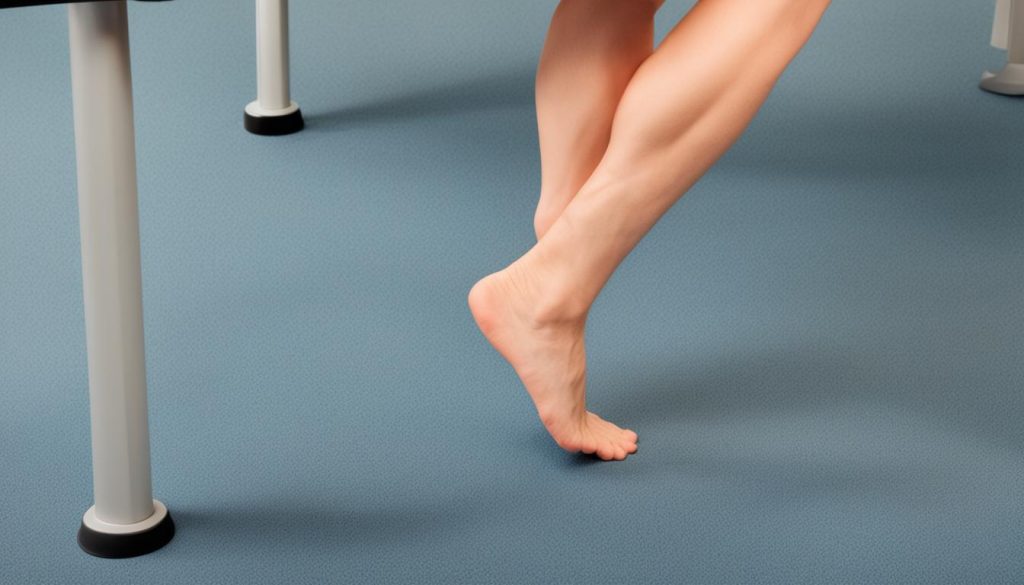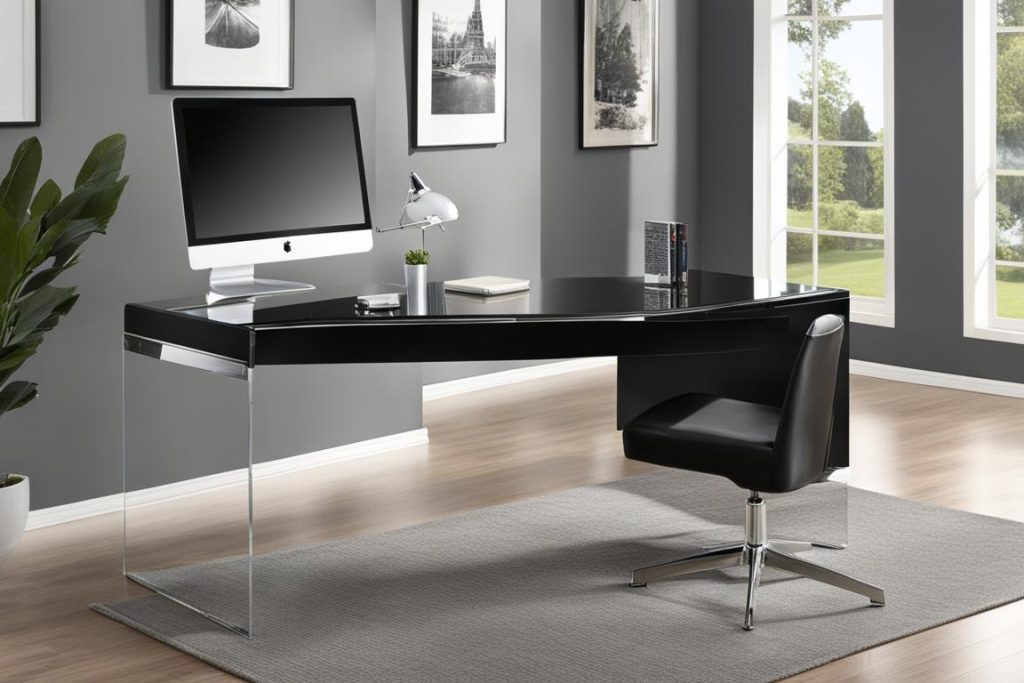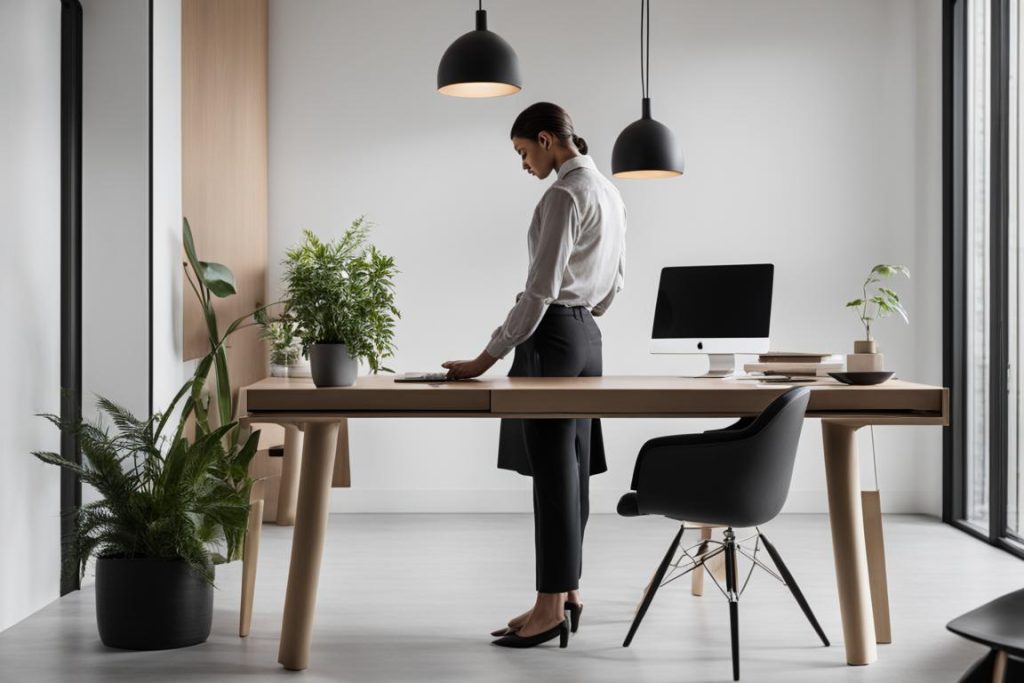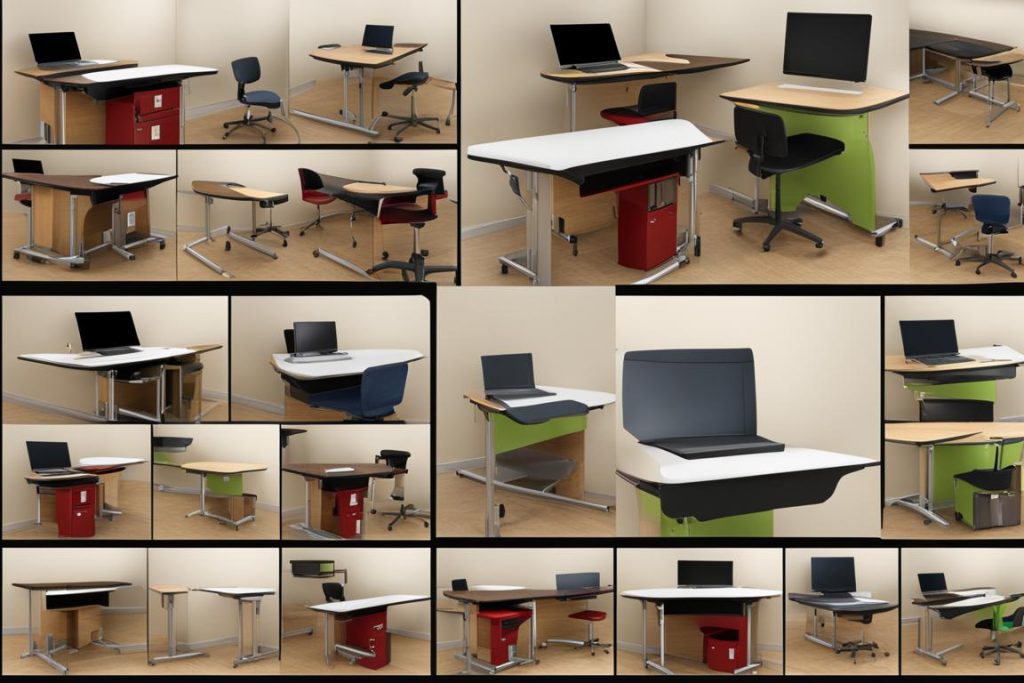Having a stable workspace is crucial for productivity. An unstable desk can cause frustration and disruptions to daily activities. There are various reasons why desks may wobble or move, such as uneven legs, an unlevel floor, loose leg components, or worn-out joints. However, there are simple and effective ways to keep desks from moving and ensure stability. By using shims, adjusting the feet, adding lateral bracing, and securing loose joints or components, you can prevent desk movement and create a steady workspace.
How to Keep Desks from Moving
- Use shims to prevent desk wobbling.
- Adjust the feet of the desk to ensure stability.
- Add lateral bracing, such as a stabilizer bar, for extra support.
- Secure loose joints or components with wood glue or L-brackets.
- Organize your desk and utilize storage solutions to maintain stability.
Reasons for Desk Wobble
When it comes to desk stability, there are several common reasons why desks wobble. Identifying these factors can help you find the right solutions to create a stable workspace.
- Uneven desk legs: One of the main culprits behind desk wobble is uneven legs. If one end of your desk is taller than the other, it can cause uneven leg measurements, leading to an unstable desk.
- Unlevel floor: An unlevel floor can also contribute to desk instability. When the floor surface is not flat, the desk may wobble, making it difficult to work comfortably.
- Loose leg components: Loose screws and bolts in the legs of your desk can result in wobbling. Over time, these components may become loose due to regular use or improper assembly.
- Worn-out joints: Desks with worn-out joints or bonding agents used in their construction are prone to wobbling. As the joints deteriorate, the desk may lose its stability and start to move.
- Incorrectly adjusted feet: Adjustable desks often have feet that can be adjusted to level the surface. If the feet are not adjusted properly, the desk may be unstable and exhibit wobbling.


How to Fix a Wobbly Desk
Is your desk constantly wobbling, making it difficult to work efficiently? Don’t worry, there are several effective methods to fix a wobbly desk and restore stability to your workspace.
1. Use Shims
One simple yet effective method to prevent desk wobbling is by using shims. Shims are thin planks of wood or other materials that you can insert between the legs of the desk. By strategically placing shims, you can create a solid foundation that prevents any unwanted wobbling or movement.
2. Adjust the Feet
Another option to stabilize your desk is by adjusting the feet. If your desk has adjustable feet, check if they are properly leveled. Uneven feet can cause instability and wobbling. Make sure all the feet are adjusted to the same height to create a stable and even surface.
3. Add Lateral Bracing
In some cases, adding lateral bracing can greatly reduce desk wobbling. Consider installing a stabilizer bar underneath the desk to provide additional support and prevent any side-to-side movement. Lateral bracing can be particularly useful for larger desks or those with heavier loads.
4. Fix Loose Joints or Components
If your desk has loose joints or components, this can contribute to an unstable workspace. Apply wood glue to any loose joints and use L-brackets to reinforce connections. By securing loose parts, you can significantly improve the stability of your desk.
5. Trim Longer Legs
If you have an adjustable desk with longer legs, they can sometimes contribute to wobbling. Consider trimming the longer legs to match the height of the shorter ones. This minor adjustment can help stabilize the desk and eliminate any wobbling caused by uneven leg lengths.
By following these desk stabilization methods, you can fix a wobbly desk and create a stable workspace that promotes productivity and comfort.
Desk Organization for Stability
In addition to preventing desk movement, organizing your desk is essential for maintaining stability and creating a clutter-free workspace. A well-organized desk not only improves productivity but also enhances the overall aesthetics of your workspace. Here are some desk organization tips to help you achieve a stable and organized desk:
1. Designated Spots for Desk Accessories
Creating designated spots for your desk accessories ensures that everything has its place and reduces clutter. Use small trays or containers to hold items like pens, paper clips, and sticky notes. Keeping these items neatly arranged prevents them from rolling around and potentially causing desk movement.
2. Utilize Desk Organizers
Desk organizers are a practical solution for keeping your workspace tidy. Invest in desk organizers with compartments and drawers to store items such as documents, stationery, and small office supplies. Having separate compartments will make it easier for you to find what you need and maintain order on your desk.
3. Utilize Vertical Space
Make the most of your vertical space by using paper tray organizers, drawer dividers, and stackable storage boxes. Vertical storage solutions not only increase storage capacity but also free up surface area on your desk. By keeping items off the desk surface, you reduce the risk of desk movement and create a more stable workspace.
4. Conceal Desk Storage
Consider using decorative desktop storage solutions to conceal your desk storage. Decorative boxes, baskets, or fabric bins can add a touch of style while keeping your documents and supplies within reach. An organized and visually appealing desk contributes to a stable and conducive work environment.
5. Utilize External Storage
If your desk lacks sufficient storage space, consider using external storage options such as filing cabinets or shelves. These additional storage solutions can help you declutter your desk and provide a more stable foundation. Keep frequently accessed items within arm’s reach and store less-used items in external storage to optimize your workspace.
By following these desk organization tips, you can create a clutter-free and stable workspace that enhances productivity and focus. Remember, an organized desk not only promotes stability but also improves your overall work experience.


Conclusion
Creating a stable and organized workspace is crucial for productivity and comfort. By addressing the underlying reasons for desk wobbling, such as uneven legs, unlevel floors, loose components, or worn-out joints, you can prevent desk movement and ensure desk stability.
Implementing simple solutions like using shims to level uneven legs, adjusting feet to create a balanced desk surface, adding lateral bracing for extra support, and securing loose components can go a long way in preventing desk wobble and creating a stable workspace.
In addition to desk stability, maintaining an organized desk further contributes to a clutter-free environment and enhances productivity. By utilizing desk organizers, vertical space, and other storage solutions, you can keep your desk tidy and ensure a stable work surface. Maximize the use of storage boxes, drawer dividers, and external storage options like filing cabinets or shelves to create a well-organized and stable workspace.
With these tips and techniques, you can maintain a stable and organized desk that provides a reliable foundation for your work. Keeping your desk steady not only prevents distractions but also sets the stage for a more focused and efficient work environment. Create the ideal workspace that promotes productivity by addressing desk movement and maintaining a clutter-free, stable desk.
FAQ
Why do desks wobble?
Desks can wobble due to uneven legs, an unlevel floor, loose leg components, or worn-out joints.
How can I fix a wobbly desk?
You can fix a wobbly desk by using shims, adjusting the feet, adding lateral bracing, or securing loose joints or components.
How can I organize my desk for stability?
Organize your desk for stability by having designated spots for accessories, using desk organizers, and utilizing vertical space and storage solutions.
Why is desk stability important?
Desk stability is important for productivity and comfort, as it prevents disruptions and provides a reliable foundation for work.






